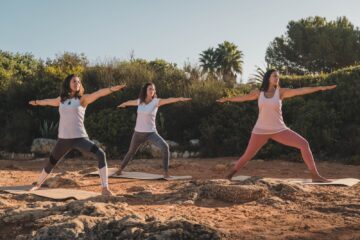The benefits of yoga extend far beyond the moment you leave the studio. Since many poses require little or no equipment, you can incorporate yoga techniques throughout your day.
Previously we’ve talked about practicing yoga on the go, in the comfort of your home, and we’ve even discussed how you can do yoga during your workday. But now, let’s talk about the benefits of incorporating yoga techniques into your day and practical ways to do so. Whether you’re working at an office job or traveling, there are simple ways to practice yoga.
Benefits of Incorporating Yoga Techniques Throughout Your Day
Many people begin yoga to improve their flexibility, balance, strength, and cardiovascular health. While yoga provides many physical benefits, it also helps with stress management and improves your mental and emotional wellbeing.
Office employees often carry a great deal of tension in their back, neck, and shoulders that result in poor posture, aches, and pain. Through regular practice, yoga techniques can reverse the symptoms associated with sitting at a desk for long periods of time.
The physical benefits of yoga may be what leads you to begin your practice. But the mental and emotional benefits will keep you practicing yoga. An ongoing practice will lead to a happier, less stressed, less anxious, and more compassionate mindset.
Practical Ways to Incorporate Yoga Techniques Throughout Your Day
Yoga is most commonly associated with improving flexibility. But there are eight limbs of yoga. In addition to asana, yoga also encompasses pranayama (breathing exercises), dhyana (meditation), yamas (codes of social conduct), niyamas (self-observances), pratyahara (withdrawal of the senses), dharana (concentration), and samadhi (bliss).
When you’re stuck in the subway, on a plane, or a passenger in a car, there may not be many poses you can perform (asana). However, that doesn’t mean you won’t benefit from pranayama (breathing exercises), dhyana (meditation), or even niyamas (self-observances).
Sometimes when we’re stressed, taking a few moments to observe our emotional and mental state is the best solution. After you’ve taken time to practice niyamas (self-observances) move into meditation to quiet your mind and rediscover your inner calm.
If space will allow (you won’t need much), there are several poses you can perform even in the tight confines of a cubicle, passenger seat, or airplane bathroom (just make sure the fasten seatbelt sign is off).
If you’re en route while traveling, you may not be able to drop down into child’s pose. So here are four simple yoga poses you can do even in your seat:
1. Seated Tadasana
Reach your arms above your head, stacking wrists over shoulders. Try to straighten your elbows as much as possible. Engage your abs as you sit up tall.
Soften your shoulders and keep your head directly over your torso, then lift your chin upward and slightly back to align your spine and find good posture.
2. Wrist and Finger Stretches
While seated, take the fingertips of one hand into the palm of your other hand. Extend that same arm forward, at shoulder-height, and gently pull your fingers down toward the back of your wrist until you feel a slight stretch. This provides relief from typing on a keyboard.
3. Chair Pigeon Pose
While sitting comfortably in a chair, inhale and raise your right leg holding it carefully with your hands and place it over the left thigh. You will feel the stretch in your hip and knee joints.
4. Seated Crescent Moon Pose
From tadasana, extend your right arm toward the left side of your body, finding as much length as possible from right hip to right armpit.
Palm can face to the left, and gaze can shift up toward your bicep if that feels okay on your neck. Create space between your shoulders and ears.
If you’re at work and have a little more room to stretch, then consider doing a couple of the following poses. These eight yoga poses can easily be performed in the privacy of your own cubicle.
1. Sit and Stand Chair Pose
Stand straight with your feet a little wider than hip-width apart and your arms at your sides.
Inhale and lift your arms next to your ears, stretching them straight and parallel with wrists and fingers straight. Keep your shoulders down and spine neutral.
Exhale as you bend your knees, keeping your thighs and knees parallel. Lean your torso forward to create a right angle with the tops of your thighs. Keep your neck and head in line with your torso and arms.
2. Desk Chaturanga
Lean your body forward from a standing position, and put your hands on a desk or hard surface shoulder-width apart. Softly look a few inches in front of your fingertips, and breathe until you’re ready to push back into a plank position to exit the pose.
3. Seated Backbend
While seated, reach your hands a couple of inches behind your hips. Push into the chair, and reach your shoulder blades down and back.
The belly is hugged in as chest lifts up and presses forward. Finish by sending your gaze up.
4. Seated Twist
With both knees facing forward, bring your left hand to your outer right knee. Sit up tall and activate your abs. The right hand can rest at your side or down by your right hip.
On every inhale, sit up a little taller, and on every exhale, move your right shoulder back an inch as the left shoulder moves forward.
Pull your left hip back as you twist to the right. Keep the twist in your lumbar spine. Maintain a steady breath and a tall spine. You can look toward the right, and eventually toward your right shoulder.
5. Shoulder Opener
Move away a few feet from your desk, and stand with your feet apart. Walk your hands forward onto a hard surface, and then create a right angle with your body.
Keep reaching your hands forward with straight arms until you feel a stretch through your chest, shoulders and upper back. Your knees can be bent or straight.
6. Forward Fold
Drop your arms to the floor, along with the top of your head. Fingertips can touch the ground, but if that’s too much, simply rest them on your shins or knees. Keep your weight even or slightly forward into the balls of your feet.
7. Forward Fold II
Reach your hands behind your low back to interlace fingertips in a bind. Press your palms toward each other as you raise your wrists away from your back. Keep tipping your head in the direction of the floor, and release your neck.
Continue to bring your wrists forward as you create more openness through your shoulders and chest.
8. Dancer’s Pose
From a standing position, bend your right knee and kick your right heel toward your glutes.
With your right hand, reach back to grab the outside or inside of your right ankle. Stand straight and stack shoulders over hips over ankles.
Press your knee down while keeping the inside of your right knee as close to the inside of your left knee as possible. Flex through your right foot, toward the back of the room, as you keep sending your knee down with hips straight forward.
Conclusion
Now you know the importance of including yoga into your day and practical ways to do it. So whether you’re at work, traveling, or on vacation, you can easily incorporate yoga techniques into your day to help you prevent stress and keep you healthy.



